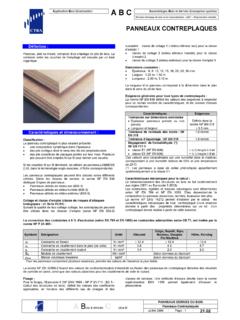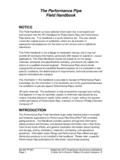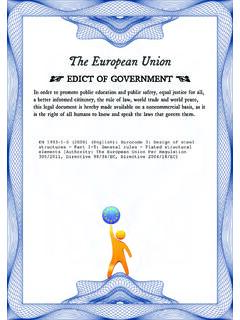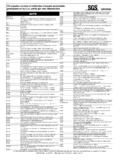Transcription of Creutzfeldt-Jakob disease (CJD) and variant CJD …
1 Creutzfeldt-Jakob disease (CJD) and variant CJD (vCJD) General introduction Creutzfeldt-Jakob disease is the prototype of a family of rare and fatal human degenerative conditions characterized by progressive brain dysfunction. CJD falls into four categories: sporadic, familial, iatrogenic and variant . Sporadic CJD (sCJD), thought to occur worldwide, is the most common form and represents about 85% of all CJD cases; incidence ranges between and cases per million inhabitants per year. variant CJD (vCJD), first recognized in the United Kingdom in 1996 has been linked to bovine spongiform encephalopathy, (BSE). Incidence is not currently monitored in many parts of the world and the size of the population exposed and susceptible to vCJD in the United Kingdom and in other parts of the world is not known. This and uncertainties relating to the potential length of the incubation period complicate predictions of the future number of vCJD cases.
2 All those who have been identified with vCJD have died. No screening test is currently available. Causal agent and main modes of transmission Causal agent: CJD is believed to be caused by a self-replicating host-encoded protein or prion protein (PrP), transmissible in the laboratory to many species, including wild and transgenic mice and non-human primates. Main modes of transmission: y For vCJD, the exact route of transmission from BSE to humans is uncertain, but is likely to be linked to contaminated foods of bovine origin. Probable secondary transmission of vCJD via blood transfusion has been reported. Incubation not known precisely, likely to be long. y Mode of transmission for sCJD is not known; de novo spontaneous generation of self-replicating protein has been hypothesized. No clear evidence of risk from diet, previous surgery, blood transfusion, occupational or animal exposure, the possibility that sporadic CJD arises through other unrecognized environmental exposure cannot be dismissed.
3 Y Familial CJD (fCJD) is an inherited condition and cases represent 20% to 15% of the total number of CJD cases. Gerstmann-Str ussler-Scheinker disease (GSS) and fatal familial insomnia (FFI) are very rare forms of fCJD. y Iatrogenic CJD infection is inadvertently transmitted usually from a case with sCJD in the course of medical/surgical treatment, human pituitary hormone therapy, human dura mater grafts, corneal grafts or neurological instruments.. disease forms and recommended case definition Sporadic CJD Possible case y Progressive dementia; and y EEG atypical or not carried out; and y duration <2 years; and y at least two out of the following clinical features: myoclonus, visual or cerebellar disturbance, pyramidal, extrapyramidal dysfunction, akinetic mutism. Probable case (in the absence of an alternative diagnosis from routine investigation) y Progressive dementia; y at least two of the following four clinical features: myoclonus, visual or cerebellar disturbance, pyramidal/extrapyramidal dysfunction, akinetic mutism, with a typical EEG (generalized triphasic periodic complexes at approximately one per second), whatever the clinical duration of the disease , and/or a positive 14-3-3 assay in CSF and a clinical duration leading to death in <2 years.
4 Definite case y Neuropathological confirmation (see end of CJD case classification below); and/or y confirmation of protease-resistant prion protein (PrP) (immunocytochemistry or Western Blot); and/or Excerpt from WHO recommended standards and strategies for surveillance, prevention and control of communicable diseases" y presence of scrapie-associated fibrils. Iatrogenic CJD Probable y Progressive cerebellar syndrome in a recipient of human cadaver-derived pituitary hormone; or y Probable CJD with a recognized iatrogenic risk. Definite y Definite CJD with a recognized iatrogenic risk. Familial CJD Probable y Probable CJD plus confirmed or probable CJD in a first degree relative; and/or y Neuropsychiatric disorder plus disease -specific prion protein gene (PRNP) mutation. Definite y Definite CJD with a recognized pathogenic PRNP mutation; and y Definite or probable TSE in a first-degree relative Note.
5 For surveillance purposes, this definition includes Gerstmann-Str ussler-Scheinker (GSS) syndrome and fatal familial insomnia (FFI). variant CJD variant CJD cannot be diagnosed with certainty on clinical criteria alone; this requires neuropathological confirmation. The following combinations of signs, symptoms and clinical investigations serve to define possible, probable and definite vCJD: (I) y Progressive psychiatric disorder y Clinical duration >6 months y Routine investigations do not suggest an alternative diagnosis y No history of potential iatrogenic exposure y No evidence of a familial form of TSE (transmissible spongiform encephalopathies). (II) y Early psychiatric symptoms (depression, anxiety, apathy, withdrawal, delusions) y Persistent painful sensory symptoms (pain and/or dysaesthesia) y Ataxia y Chorea / dystonia or myoclonus y Dementia.
6 (III) y EEG unknown or does not show the typical appearance of sporadic CJD (generalized triphasic periodic complexes at approximately one per second) y Bilateral symmetrical pulvinar high signal on MRI brain scan (relative to other deep gray-matter nuclei). (IV) y Positive tonsil biopsy. Note. Tonsil biopsy not recommended routinely nor in cases with EEG appearances typical of sporadic CJD, but useful in suspect cases where clinical features are compatible with vCJD and MRI does not show bilateral pulvinar high signal. Cerebral biopsy in living patients is to be discouraged unless its purpose is to arrive at an alternative diagnosis of a treatable disorder. vCJD case classification Possible y A patient with the items under (I) above and at least 4 items under (II) y EEG does not show the typical appearance of sporadic CJD Probable y A patient with the items under (I) and at least four items under (II) y Bilateral pulvinar high signal on MRI brain scan y EEG does not show the typical appearance of sporadic CJD although generalized periodic complexes may occasionally be seen at the later stages of the disease .
7 OR y A patient with items under (I) and a positive tonsil biopsy. Definite y A patient with the items under (I) above Excerpt from WHO recommended standards and strategies for surveillance, prevention and control of communicable diseases" y Neuropathological confirmation of vCJD. Neuropathological criteria (CJD and other human transmissible spongiform encephalopathies) Creutzfeldt-Jakob disease : sporadic, iatrogenic (recognized risk) or familial (same disease in first-degree relative or disease -associated PRNP mutation): y spongiform encephalopathy in cerebral and/or cerebellar cortex and/or subcortical grey matter; and/or y encephalopathy with prion protein (PrP) immunoreactivity (plaque and/or diffuse synaptic and/or patchy/perivacuolar types). variant CJD y Spongiform encephalopathy with abundant PrP deposition, in particular multiple fibrillary PrP plaques surrounded by a halo of spongiform vacuoles ("florid" plaques, "daisy-like" plaques) and other PrP plaques, and amorphous pericellular and perivascular PrP deposits especially prominent in the cerebellar molecular layer.
8 Gerstmann-Str ussler-Scheinker disease (in family with dominantly inherited progressive ataxia and/or dementia and one of a variety of PRNP mutations) y Encephalo(myelo)pathy with multicentric PrP plaques; y Thalamic degeneration, variable spongiform change in cerebrum. Kuru Spongiform encephalopathy in the Fore population of Papua New Guinea. Surveillance Rationale for surveillance Global surveillance of vCJD and other forms of CJD should lead to a better understanding of the disease , including potential causes of iatrogenic CJD, as well as the distribution of various hereditary forms. It should also provide information towards protection against the risks of disease . Recommended types of surveillance y One centre must be identified at central level to carry out surveillance. y All definite, probable and possible cases must be notified by the appropriate health care professionals (usually physicians, neurologists, psychiatrists, neuropathologists) to the centre responsible for surveillance.
9 Y Check death registrations in order to identify cases not detected by routine surveillance. Recommended minimum data elements Case-based record y Subtype and classification of CJD. y Age, sex, country of birth, geographical information, occupation. y Date of onset, date of death. y Vital status (alive, dead). Aggregated data reporting. All reporting should be case-based. Recommended data analyses, presentation, reports y Number of cases by subtype, classification, occupational group, geographical area. y Number of cases by year of death, by age at death. y Sex ratio. Performance indicators for surveillance. Time between onset of symptoms and reporting. Control activities Case management Supportive case management (no specific treatment). The disease is always fatal. Prevention y Avoiding exposures to BSE-causing agent in food of bovine origin: Excerpt from WHO recommended standards and strategies for surveillance, prevention and control of communicable diseases" BSE is a risk to animal and public health.
10 It is transmissible to humans and food is considered the most likely source of exposure. Bovines, bovine products and by-products potentially carrying the BSE agent have been traded worldwide, giving this risk a global dimension, with possible repercussions on public health, animal health and trade. At this time protecting public health from exposure through food is primarily accomplished by preventing and eliminating BSE in livestock populations. For further information consult report of the Joint WHO/FAO/OIE technical consultation on BSE: public health, animal health and trade (see Bibliography below). y Avoiding iatrogenic exposures: Specific precautions should be taken in the management of persons with confirmed or suspected transmissible spongiform encephalopathy (TSEs) and their tissues. The following persons have been regarded as "at risk" for developing TSE: recipients of human dura mater, of human cadaver-derived pituitary hormones especially human cadaver derived growth hormone, of cornea transplants, persons undergoing neurosurgery and members of families with heritable TSE.















